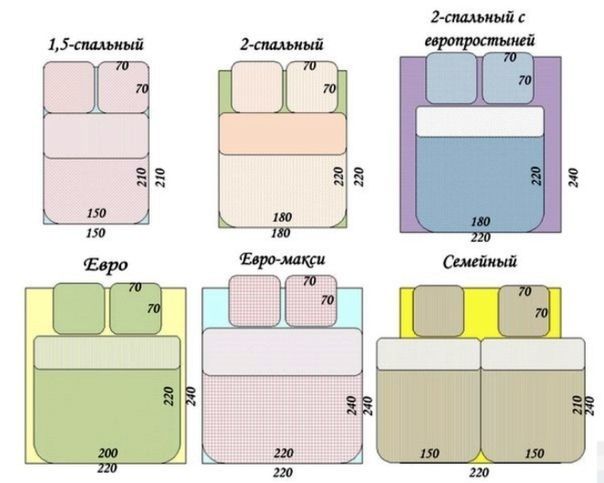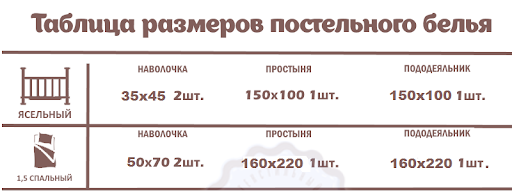How much fabric is needed to sew one and a half, double and children's duvetel? Patterns and sewing patterns of ductiles of different sizes. Linen seams and tips.
Content
- How to sew a duvetel 1.5 sleeping, 2 sleeping or children - dimensions
- How to sew a duvetail without a pattern?
- Scheme of the Pattern for the Todalizer from a fabric 220 cm wide
- Video: Calculation of fabric when sewing a duvet
- How to sew a duvetel - choosing a fastener
- Video: How to sew a zipper in a duvetail?
- Video: How to make loops on a duvetail?
- Video: How to sew a duvetel with a round hole?
- How to sew a duvetel - a quarrel of a linen seam
- Video: How to make a seam for bedding?
If you need advice on how to sew a duvetel 1.5 sleeping, 2 sleeping or childish, this article will help to figure out how much fabric is needed for this, what are the most convenient and practical options, and how easier it is to sew them.
How to sew a duvetel 1.5 sleeping, 2 sleeping or children - dimensions


The reasons why it is better to sew a duvetail with your own hands, and not buy it in the store:
- You have a non -standard blanket.
- It is difficult for you to choose ready -made duvetings, because you do not like their fasteners or sizes.
- You are tired of pouring the blanket into too small or too much a duvetel.
- You want exclusive bedding.
- You want to save some money.
If at least one of these reasons is yours, feel free to take up the sewing, not forgetting to measure seven times and cut off once. In fact, there is nothing easier than to sew two rectangles and come up with what a clasp on the duvetail will be.
How to sew a duvetail without a pattern?
To sew a duvetail without a pattern, it is enough to know the length and width of your blanket. So that there is no grief, thoroughly measure it. To do this, put the blanket on the floor, smooth the folds, if you turn out and, without pulling the fabric, measure the length and width of the blanket. The dimensions obtained will be the basis for the duvetor pattern. You need to add to these measurements allowances for seams, and this is about 3 cm on each side Or just add 6 cm.
Do not forget that the thickness of the blankets also needs to be taken into account when sewing a duvetail. So for a thin blanket up to 1 cm, you can not add anything. For a blanket of medium thickness 2-3 cm. And for a thick blanket 4-5 cm. In order not to make a mistake, attach the ruler to the blanket that lies on the floor, and visually determine this size.
The width of the fabric for the duvetail can be different, and when calculating its consumption, you need to rely on the width of the fabric that you are going to buy.
If you take a narrow cotton fabric with a width of 90-95 cm for sewing, then your duvetel will consist of strips of this fabric in the length of your blanket. So for sewing a duvetail 2-3 stripes may be needed.

Consider the consumption of fabric for a children's tint from a standard standard size 90 - 95 cm wide:
If you want to sew a children's tint of fabric, 95 cm wide, then this width will not be enough on one side of the duvetail, if the width of the blanket, for example, is 110 and a length of 140 cm. This means that you will have to buy three lengths, plus allowances for the seams. In our example, it is 140 by multiply by 3, and add about 20 cm of allowances. Total, fabric consumption will be 4 meters 40 cm.
Pillowcases for small pillows can be sewn from the remnants of the fabric.
On the duvetel for one and a half blanket, with a width of 140 cm you will need a piece of fabric 95 cm wide and the length of the blanket multiplied by 4.
Will 3 lengths be enough for sewing a half -time blanket?
- A simple calculation shows that if the width of the fabric is 95 cm, then we need to multiply by 3, and we get 285 cm. On the seams, if the width of the blanket is 140 cm, it will only be 5 cm. This may be enough if the blanket is thin, or maybe maybe the blanket It is not enough if the blanket is thick.
- For a duvetel of a double blanket 172 cm wide, you will need to buy 4 lengths if you sew 95 cm wide from a fabric.
- The larger the width of the fabric, the less you will need to buy it. If you do not know how to sew a duvetel 1.5 sleeping, 2 sleeping, children from fabric 220 cm wide, also rely on the length of your blanket.

Consider the consumption of fabric for a duvetel from a chintz 220 cm wide:
If the length of your blanket is not more than 215 cm, then when sewing a duvetor from a fabric 220 cm wide, it is enough to measure the width of the blanket and buy fabric at the rate of 2 width of the blanket plus allowances for the seams.
Such wide fabrics are created specifically to sew a duvetel with your own hands, as well as a sheet and other bedding. The drawing on such fabrics also takes into account that it is a fabric for bedding, and it is not located vertically, but horizontally relative to the edge of the fabric.

Scheme of the Pattern for the Todalizer from a fabric 220 cm wide
Bed linen fabrics 220 cm wide allowed to spend matters more economically, and leave less scraps. In addition, they save time for sewing. One of the sides of the duvetail can not be processed, but simply bend the fabric in this place in half.
Scheme of the Pattern for the Croching from a fabric 220 cm wide:

On a duvetel for a children's blanket 100 cm wide, you will need a piece of fabric size as one length of a blanket plus allowances for the seams.
Video: Calculation of fabric when sewing a duvet
How to sew a duvetel - choosing a fastener
Varieties of fasteners:
- Furfacing for the duvetail on buttons.
- Flasp for a duvetail with a zipper.
- Clasp in the form of smell of fabric and Velcro.
- A secret fastener at the seams with a secret lightning.
- The "Soviet" fastener in the form of a rhombus or square at the top of the duvetail.
The simplest fastener for a duvetail at the seams is obtained if one of the seams is left not stitched by a plot of 30-40 cm long. The disadvantages of such a clasp may be tissue breaks when dressed on a blanket. If you insert into such a seam lightning fastener, then there will be no gaps of the fabric, and the duvetel itself will look neat.
Video: How to sew a zipper in a duvetail?
- Claim for a duvetail smell, It requires increasing the consumption of fabric. When sewing, a duvetail with a smell, one of the sides is made 30-40 cm longer and simply touched it inside.
- Claim fastener on buttons It requires the seam to create loops in the fabric. But if on an unnecessary flap of fabric you can make several loops, then you will succeed on the loops on the duvetail.
Video: How to make loops on a duvetail?
- "Soviet fastener" In the form of a rhombus, square or circle in the middle, for those who want to show a beautiful blanket or nostalgic for times of the USSR. However, it is quite difficult to make a neckline in fabric and process the edge of such a duvetel.
Video: How to sew a duvetel with a round hole?
Do not be upset if you have fabric left when sewing a duvetail, because pillowcases for large and small pillows can be made from it. If such pillows will be sewn from different fabrics, and will not completely coincide with a set of bedding, it will be even more interesting. This option is possible if you sew a set of bedding from two different types of fabric.
How to sew a duvetel - a quarrel of a linen seam
When stitching the fabric strips without the use of an overlock, a quarrel of linen seam is used.
How to sew a duvetail:
- Two fabric canvases are folded in the front side.
- In this case, one canvas protrudes over the edge of the other by 2 cm.
- Wrap the protruding land on another canvas.
- Sew two canvases together.
- Turn the stitched fabric.
- The resulting seam is sewn to one of the paintings.
You can also apply the following life hack, which will simplify sewing bedding.
- Fold two stripes of fabric together the wrong side inside.
- Sew them with one line about 0.8 cm from the edge.
- Turn the stitched fabric and defeat with an iron.
- Fold the fabric the front side Inside and sew the canvases, retreating from the edge by about 1 -1.2 cm.
- As a result, you will get a closed linen seam.

On our site there are many other important articles about sewing bedding:
- How to sew a sheet on an elastic band with your own hands?
- Sewing the pillowcases of ordinary and decorative.
- Washing bedding from different types of fabric.
- The color of the bed linen on Feng Shui, what should the drawing be so that the life of the owners of the house is going along?








I need how to properly cut bedding from a 220 width of fabric